Pasta Recipes
Authentic Trofie Pasta Recipe for a Traditional Italian Experience

When we think about authentic Italian cuisine, few dishes capture the simplicity and depth of flavor like Trofie pasta. Originating from the Ligurian region in Northern Italy, this pasta has earned its place as a beloved staple in Italian households. Its twisted, short shape makes it ideal for soaking up the rich sauces that characterize traditional Italian dishes.
In this article, we will guide you through a detailed and authentic Trofie pasta recipe, focusing on the original method that has been passed down through generations. We will also explore the history, preparation, and ideal pairings to provide you with a traditional Italian experience that you can recreate in your own kitchen.
The Origins of Trofie Pasta
Trofie pasta holds a special place in Italian culinary history. It originated in Liguria, a coastal region renowned for its basil pesto and maritime culture. The pasta’s unique, spiral shape is said to have been inspired by the rolling waves of the Ligurian Sea. Traditionally, this pasta was made by hand, using a simple dough of wheat flour and water. The dough is rolled into small, twisted pieces, creating the distinct texture and appearance that makes Trofie stand out.
Today, while it can be found in many Italian supermarkets, homemade Trofie is still the preferred option for those seeking an authentic Italian meal.
Ingredients for Authentic Trofie Pasta
To make the best Trofie pasta from scratch, you need only a few simple ingredients. The beauty of this recipe lies in its simplicity, allowing the pasta’s unique texture and the sauce’s vibrant flavors to shine. Here’s what you’ll need:
- 500g of semolina flour
- 250ml of lukewarm water
- A pinch of salt
For the traditional pesto alla Genovese sauce (the most common pairing with Trofie pasta):
- 100g of fresh basil leaves
- 50g of pine nuts
- 2 cloves of garlic
- 100g of grated Parmesan cheese
- 50g of grated Pecorino cheese
- 100ml of extra virgin olive oil
- Salt to taste
Step-by-Step Guide to Making Authentic Trofie Pasta
1. Preparing the Dough
Begin by placing the semolina flour in a large mixing bowl. Slowly add the lukewarm water, mixing it with your hands or a wooden spoon until a dough starts to form. Add a pinch of salt for flavor. Knead the dough on a lightly floured surface for about 10 minutes until it becomes smooth and elastic.
Once the dough reaches the desired texture, cover it with a clean towel and let it rest for 30 minutes. This resting period allows the dough to become more pliable, making it easier to shape into Trofie.
2. Shaping the Trofie
To shape the Trofie pasta, pinch off small pieces of dough, roughly the size of a hazelnut. Roll each piece between your palms into a small cylinder, then use your fingertips to twist the dough, creating the spiral shape. The goal is to achieve small, twisted pieces that are about 2-3 centimeters in length. This technique may take some practice, but once you get the hang of it, the process becomes quite therapeutic.
Place the shaped Trofie on a floured surface to prevent sticking as you continue shaping the rest of the dough.
3. Cooking the Trofie Pasta
Bring a large pot of salted water to a boil. Drop the Trofie into the boiling water, stirring occasionally to prevent clumping. Fresh Trofie will cook quickly, typically within 3-4 minutes. You’ll know it’s done when the pasta floats to the surface and has a slightly firm, al dente texture.
Drain the pasta, but be sure to reserve a cup of the pasta cooking water, which can be used to adjust the consistency of your sauce later.
Pesto alla Genovese: The Perfect Companion for Trofie
No authentic Trofie pasta recipe would be complete without the classic pesto alla Genovese. This fragrant sauce, made with fresh basil, pine nuts, and Parmesan cheese, is a staple in Ligurian cuisine and pairs perfectly with Trofie.
1. Preparing the Pesto
In a food processor, combine the basil leaves, pine nuts, and garlic. Pulse until the ingredients are finely chopped. Slowly add the extra virgin olive oil while continuing to pulse, until the mixture becomes a smooth paste.
Transfer the pesto to a bowl and stir in the grated Parmesan and Pecorino cheeses. Season with salt to taste. If the pesto is too thick, you can add a tablespoon of the reserved pasta cooking water to achieve the desired consistency.
2. Tossing the Trofie with Pesto
Once the Trofie is cooked and drained, transfer it to a large serving bowl. Add the pesto alla Genovese and toss the pasta until it’s evenly coated. If the sauce seems too thick, gradually add a little of the reserved pasta cooking water to help it adhere better to the pasta.
3. Serving Suggestions
For an extra touch of authenticity, garnish the dish with a few whole basil leaves and a sprinkle of grated Parmesan cheese. Serve the Trofie immediately, while the pasta is still hot and the pesto is fresh.
Other Delicious Pairings for Trofie Pasta
While pesto alla Genovese is the traditional accompaniment for Trofie, there are other sauces that complement this pasta’s unique texture:
Trofie with Tomato and Olive Sauce
A simple tomato and olive sauce brings out the best in Trofie. Sauté garlic in olive oil, add chopped tomatoes, and simmer with kalamata olives. Finish with fresh basil for a Mediterranean twist.
Trofie with Creamy Walnut Sauce
For a richer, heartier option, try a creamy walnut sauce. Blend walnuts with cream, garlic, and Parmesan for a sauce that clings perfectly to the spiral shapes of Trofie.
Trofie with Seafood
Trofie also pairs wonderfully with seafood. A light lemon butter sauce with shrimp or mussels enhances the delicate flavor of the pasta without overpowering it.
Tips for Making the Perfect Trofie Pasta
- Use high-quality semolina flour: The quality of the flour will greatly affect the texture of your pasta. Opt for durum wheat semolina for the best results.
- Don’t overcook the Trofie: Fresh pasta cooks quickly, so keep a close eye on it to avoid a mushy texture.
- Keep the pesto fresh: Pesto is best when made fresh and served immediately. If you need to store it, cover the surface with a thin layer of olive oil to prevent oxidation.
Read More : Garlic Parmesan Chicken Pasta Recipe: A Creamy, Flavorful Meal
Faq’s
1. What is Trofie pasta?
Trofie is a traditional Italian pasta that originated in the Ligurian region of Italy. It is known for its short, twisted shape, which helps it hold onto sauces like pesto alla Genovese.
2. What is the best sauce for Trofie pasta?
The most common and traditional sauce for Trofie is pesto alla Genovese, a fragrant sauce made from fresh basil, pine nuts, garlic, Parmesan, Pecorino cheese, and olive oil. However, Trofie also pairs well with tomato-based, walnut, and seafood sauces.
3. Can I make Trofie pasta at home?
Yes! Trofie pasta is made with just semolina flour, water, and salt. While it can take some practice to shape the twisted pasta by hand, homemade Trofie is worth the effort for its authentic texture and taste.
4. How do you cook Trofie pasta?
Fresh Trofie pasta cooks quickly, usually in 3-4 minutes in boiling salted water. If you’re using dried Trofie, it will take slightly longer. Always cook it until al dente, where the pasta is tender but still firm.
5. What flour is used to make Trofie pasta?
The traditional flour used for Trofie pasta is semolina flour, which is made from durum wheat. This type of flour gives the pasta its characteristic firm texture and helps it hold its shape during cooking.
6. How do I store homemade Trofie pasta?
Fresh Trofie can be stored in the refrigerator for up to 2 days in an airtight container. If you want to store it longer, you can dry the pasta by leaving it out in a single layer for several hours, then storing it in a cool, dry place.
7. Can Trofie pasta be frozen?
Yes, you can freeze fresh Trofie pasta. After shaping the pasta, lay it out on a floured baking sheet and freeze it until solid. Then, transfer the frozen pasta to an airtight bag or container and store it in the freezer for up to 2 months.
8. What makes Trofie different from other types of pasta?
Trofie’s distinctive twisted shape is unique and allows it to hold sauces, especially pesto, more effectively than smoother pasta shapes. It’s also one of the few pasta types that is still commonly shaped by hand.
9. Is Trofie pasta gluten-free?
Traditional Trofie pasta is made from semolina flour, which contains gluten. However, you can find or make gluten-free versions of Trofie using alternative flours, like rice or chickpea flour.
10. What are other popular dishes to pair with Trofie?
Apart from pesto alla Genovese, Trofie is commonly paired with seafood sauces, tomato and olive sauces, and creamy walnut sauce. It can also be enjoyed with simple olive oil and garlic for a lighter dish.
Conclusion
Mastering the art of making Trofie pasta is a rewarding experience that transports you to the heart of Italian cuisine. With its unique shape and rich history, Trofie brings a taste of Liguria to your kitchen. Whether you pair it with a traditional pesto or experiment with other sauces, this pasta is sure to impress and satisfy.
Pasta Recipes
test
test
Pasta Recipes
Creamy Mushroom Pasta Recipes That Are Irresistible
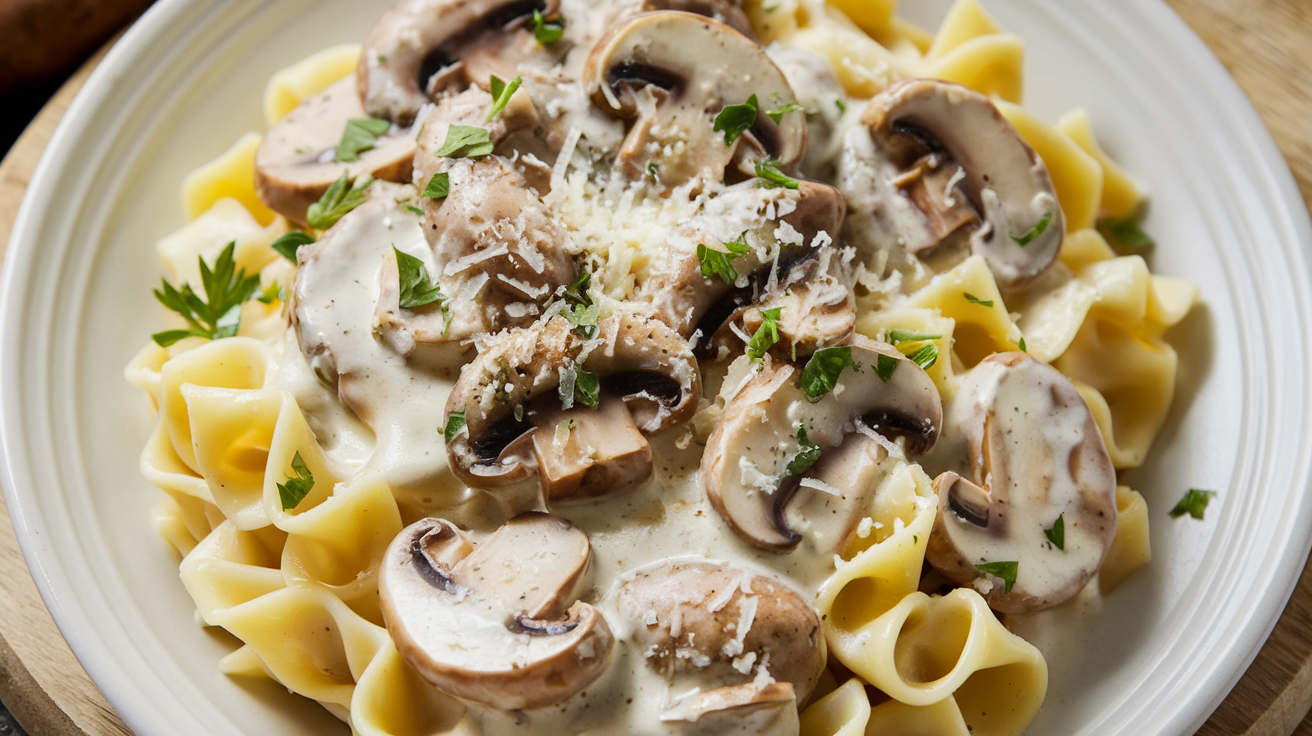
Creamy Mushroom Pasta Recipes That Are Irresistible
Creamy mushroom pasta is a comforting dish that combines rich, earthy flavors with the silkiness of a cream-based sauce. Whether you’re a seasoned cook or just beginning your culinary journey, creamy mushroom pasta is an easy yet indulgent dish that brings a touch of gourmet dining to your home. This article will introduce you to some delicious creamy mushroom pasta recipes that are irresistible, versatile, and perfect for any occasion. So, grab your ingredients and prepare to make a meal that everyone will love!
The Allure of Creamy Mushroom Pasta
Mushrooms are not only packed with nutrients, but they also offer a unique, savory flavor that elevates a dish. When combined with a creamy sauce, the umami notes from the mushrooms blend seamlessly with the richness of cream, butter, and cheese, creating an irresistible flavor profile. Creamy mushroom pasta is versatile and can be tailored to different tastes by adding ingredients like spinach, garlic, or Parmesan. It’s a satisfying dish, ideal for cozy nights in or entertaining guests.
Let’s dive into some delightful creamy mushroom pasta recipes that are sure to impress your family and friends.
Classic Creamy Mushroom Pasta
If you’re looking for a traditional take on creamy mushroom pasta, this classic recipe is the way to go. It’s simple, flavorful, and made with just a few key ingredients.
Ingredients:
- 300g pasta (penne, fettuccine, or spaghetti)
- 250g mushrooms (button, cremini, or a mix of your favorite)
- 2 tbsp olive oil
- 1 tbsp butter
- 2 cloves garlic, minced
- 200ml heavy cream
- 50g Parmesan cheese, grated
- Salt and pepper to taste
- Fresh parsley for garnish
Instructions:
- Cook the pasta in salted boiling water until al dente. Drain and set aside.
- In a large pan, heat olive oil and butter over medium heat. Add the minced garlic and sauté for a minute until fragrant.
- Add the sliced mushrooms to the pan and cook until they become soft and golden brown, about 5-7 minutes.
- Stir in the heavy cream, bring to a gentle simmer, and cook for 3-5 minutes until the sauce thickens.
- Add the Parmesan cheese and stir until melted and combined.
- Season with salt and pepper to taste.
- Toss the cooked pasta into the sauce, ensuring it is fully coated.
- Garnish with fresh parsley and serve hot.
This classic creamy mushroom pasta is incredibly comforting and easy to make. It’s the perfect dish when you’re craving something quick but luxurious.
Creamy Garlic Mushroom Pasta with Spinach
Adding spinach to creamy mushroom pasta not only adds a pop of color but also brings additional nutrients to the dish. The combination of garlic, spinach, and mushrooms creates a well-balanced and hearty meal.
Ingredients:
- 300g fettuccine
- 200g mushrooms, sliced
- 2 cups fresh spinach
- 3 cloves garlic, minced
- 2 tbsp olive oil
- 1 cup heavy cream
- 1/2 cup vegetable broth
- 50g Parmesan cheese, grated
- Salt and pepper to taste
Instructions:
- Cook the fettuccine according to package instructions, drain, and set aside.
- In a large pan, heat the olive oil over medium heat. Add the minced garlic and sauté until golden.
- Add the sliced mushrooms and cook until softened and browned, about 5 minutes.
- Stir in the spinach and cook until wilted.
- Pour in the vegetable broth and heavy cream, bringing the mixture to a simmer.
- Add the Parmesan cheese and stir until melted. Let the sauce thicken for about 2-3 minutes.
- Season with salt and pepper to taste.
- Combine the pasta with the creamy mushroom spinach sauce and toss until well-coated.
- Serve with a sprinkle of Parmesan and enjoy!
This garlic-infused creamy mushroom pasta recipe is perfect for a satisfying dinner, combining the creaminess of the sauce with the fresh taste of spinach.
Vegan Creamy Mushroom Pasta
For those who follow a plant-based diet, creamy mushroom pasta can still be enjoyed! This vegan version is made with dairy-free cream and packed with rich flavors. It’s the ultimate comfort food, without any animal products.
Ingredients:
- 300g pasta (your choice)
- 250g mushrooms (cremini or portobello)
- 2 tbsp olive oil
- 1 onion, finely chopped
- 2 cloves garlic, minced
- 1 cup coconut cream or cashew cream
- 1/4 cup nutritional yeast
- 1 tbsp lemon juice
- Salt and pepper to taste
- Fresh basil for garnish
Instructions:
- Cook the pasta as per package directions, drain, and set aside.
- In a large skillet, heat the olive oil over medium heat and sauté the chopped onions and garlic until soft and translucent.
- Add the mushrooms and cook until golden brown and tender.
- Stir in the coconut cream or cashew cream and bring the mixture to a simmer.
- Add the nutritional yeast, lemon juice, salt, and pepper to the sauce.
- Let the sauce thicken slightly, then toss the cooked pasta into the pan and mix well.
- Garnish with fresh basil and serve.
This vegan creamy mushroom pasta is indulgent and flavorful, proving that you don’t need dairy to create a rich, creamy sauce.
Creamy Mushroom Pasta with Truffle Oil
If you’re looking to elevate your creamy mushroom pasta, truffle oil is the secret ingredient. It adds a luxurious, earthy aroma and takes the dish to gourmet levels.
Ingredients:
- 300g tagliatelle
- 200g mixed mushrooms (shiitake, oyster, and button)
- 2 tbsp olive oil
- 1 shallot, minced
- 1/2 cup heavy cream
- 1 tbsp truffle oil
- 50g Parmesan cheese, grated
- Salt and pepper to taste
- Fresh thyme for garnish
Instructions:
- Cook the tagliatelle in salted water until al dente. Drain and set aside.
- In a large pan, heat the olive oil over medium heat and sauté the minced shallot until softened.
- Add the mixed mushrooms and cook for about 5-7 minutes until they become golden and tender.
- Stir in the heavy cream and allow the sauce to simmer and thicken.
- Remove the pan from the heat and drizzle in the truffle oil. Stir until combined.
- Toss the pasta in the sauce, ensuring each strand is coated.
- Top with Parmesan cheese and fresh thyme before serving.
This creamy mushroom pasta recipe with truffle oil is perfect for a special occasion or a date night at home. The truffle oil enhances the earthy flavor of the mushrooms and adds a touch of luxury to this simple dish.
Frequently Asked Questions
What mushrooms are best for creamy mushroom pasta?
The best mushrooms for creamy mushroom pasta are cremini, button, shiitake, and portobello. You can use a combination of these for added flavor and texture.
Can I make creamy mushroom pasta ahead of time?
Yes, you can make creamy mushroom pasta ahead of time. Prepare the sauce and pasta separately, and combine them just before serving. Reheat the sauce gently on the stove before mixing it with the pasta.
How do I store leftover creamy mushroom pasta?
Leftover creamy mushroom pasta can be stored in an airtight container in the refrigerator for up to three days. When reheating, add a splash of cream or milk to revive the sauce’s texture.
Is creamy mushroom pasta gluten-free?
The pasta itself determines whether the dish is gluten-free. Simply swap out regular pasta for gluten-free pasta, and the rest of the recipe can remain unchanged.
Can I make creamy mushroom pasta without cream?
Yes! You can substitute heavy cream with cashew cream, coconut milk, or even dairy-free alternatives like almond cream for a lighter version of the dish.
What can I serve with creamy mushroom pasta?
Creamy mushroom pasta pairs well with garlic bread, a fresh green salad, or roasted vegetables. These sides help balance out the richness of the pasta.
Conclusion
Creamy mushroom pasta is an incredibly versatile dish that can be adjusted to suit various dietary preferences and flavor profiles. Whether you prefer a classic recipe, a plant-based alternative, or want to add a gourmet touch with truffle oil, these recipes are guaranteed to be a hit. The rich, creamy sauce combined with the earthy flavor of mushrooms creates a pasta dish that is both comforting and indulgent.
For more exciting recipe ideas, visit Foodies Den!
Pasta Recipes
7 Fiery Spicy Pasta Dishes That Heat Seekers Will Love! 🌶️

7 Fiery Spicy Pasta Dishes That Heat Seekers Will Love! 🌶️
If you’re a lover of bold flavors and enjoy a good fiery kick in your meals, spicy pasta dishes should be at the top of your list! Combining the comforting textures of pasta with the punch of heat, these dishes deliver a perfect blend of satisfaction and excitement. Whether you’re craving a classic Italian arrabbiata or something with a fusion twist like spicy Thai noodles, these pasta dishes will make you break a sweat in the most delightful way.
Let’s dive into some of the most tantalizing spicy pasta dishes that are sure to ignite your taste buds!
Why Spicy Pasta Dishes Are a Must-Try
Spicy pasta dishes combine the best of both worlds – the warmth and comfort of pasta, paired with the invigorating heat of spices and peppers. Not only do these dishes offer dynamic flavors, but the spice can also bring several health benefits. Capsaicin, the active component in chili peppers, is known to boost metabolism and enhance digestion. Plus, for those who enjoy the endorphin rush from spicy foods, these pasta dishes offer an ideal experience.
But the beauty of spicy pasta is how adaptable it is. Depending on your spice tolerance, you can adjust the heat level by adding more (or less) chili flakes, hot sauces, or spicy sausages. So, whether you’re a daring heat-seeker or just want a bit of a kick, there’s a spicy pasta dish for everyone.
Arrabbiata – The Classic Italian Spicy Pasta Dish
When we talk about spicy pasta dishes, arrabbiata always comes to mind. Originating from the Lazio region of Italy, this dish is made with simple, yet bold ingredients: tomatoes, garlic, and red chili peppers. The name “arrabbiata” translates to “angry” in Italian, reflecting the fiery heat of the sauce.
Ingredients:
- Penne pasta
- Tomatoes (fresh or canned)
- Garlic cloves
- Red chili flakes
- Olive oil
- Fresh basil
The sauce for arrabbiata is quick to prepare, but it’s the red chili peppers that steal the show, adding layers of heat and flavor to the dish. For a more intense kick, opt for crushed red pepper flakes or even fresh hot peppers. Don’t forget to garnish it with a bit of freshly grated Parmesan cheese and basil to balance the heat.
Spicy Cajun Pasta – A Southern Delight
Next on the list of must-try spicy pasta dishes is the crowd-pleasing Cajun pasta. This Southern-inspired dish brings a rich, smoky heat, thanks to the flavorful blend of Cajun spices. It usually includes chicken or shrimp, but you can easily make it vegetarian by adding bell peppers and mushrooms.
Ingredients:
- Fettuccine pasta
- Chicken or shrimp (optional)
- Bell peppers
- Cajun seasoning (a mix of paprika, cayenne, garlic powder, and thyme)
- Cream or milk
The secret to the perfect Cajun pasta lies in its spice mix. Cajun seasoning combines heat with aromatic spices, which create a robust, bold flavor profile. The creamy sauce mellows out the spiciness, making this a balanced yet exciting meal for any heat lover.
Spaghetti Aglio e Olio with Chili
For something simple yet incredibly flavorful, spaghetti aglio e olio with chili is a fantastic choice. This Italian classic usually calls for just olive oil, garlic, and parsley, but to give it that heat-seeker’s twist, adding chili flakes or fresh red chilies is key.
Ingredients:
- Spaghetti
- Olive oil
- Garlic cloves
- Red chili flakes or fresh chilies
- Fresh parsley
- Parmesan cheese (optional)
This dish allows the spicy element to shine, especially if you use fresh chilies. The oil absorbs the heat from the garlic and chili, creating a light yet potent sauce that clings perfectly to the spaghetti. For an added layer of flavor, you can sprinkle a bit of lemon zest on top to cut through the spice.
Spicy Thai Peanut Pasta
If you’re looking to explore global flavors in your spicy pasta dishes, try a spicy Thai peanut pasta. This dish features the unique combination of creamy peanut sauce, lime juice, and red chili paste, offering a rich, spicy, and tangy experience.
Ingredients:
- Rice noodles or linguine
- Peanut butter
- Soy sauce
- Red chili paste
- Lime juice
- Crushed peanuts
- Fresh cilantro
Thai red chili paste brings a fiery element to the dish, which is balanced by the creamy richness of peanut butter. Garnished with cilantro and crushed peanuts, this pasta dish delivers a zesty, spicy, and umami-packed flavor punch that heat seekers will love.
Spicy Pesto Pasta – A Twist on a Classic
For those who love basil pesto but crave a little more excitement, spicy pesto pasta is the perfect way to turn up the heat on this classic dish. By adding jalapeños or red chili flakes to traditional pesto, you can give your pasta a bold and fiery edge.
Ingredients:
- Fusilli or penne pasta
- Basil leaves
- Pine nuts or walnuts
- Olive oil
- Garlic cloves
- Parmesan cheese
- Jalapeños or red chili flakes
The spicy element cuts through the creaminess of the pesto, making each bite refreshing yet spicy. Serve it with grilled chicken or shrimp for a heartier meal, or keep it vegetarian by adding roasted vegetables.
Linguine Fra Diavolo – Devilishly Spicy Seafood Pasta
The name “fra diavolo” means “brother devil,” which already suggests the fiery nature of this spicy pasta dish. Often made with seafood like shrimp or lobster, this dish includes tomatoes, garlic, white wine, and, of course, plenty of red pepper flakes.
Ingredients:
- Linguine pasta
- Shrimp or lobster
- Crushed tomatoes
- White wine
- Garlic cloves
- Red pepper flakes
- Fresh parsley
The red pepper flakes create a punchy sauce that pairs beautifully with the sweetness of the seafood. For an even more intense heat, some cooks add extra fresh chilies. This dish is perfect for heat seekers who love seafood with their spice.
Chipotle Mac and Cheese – A Spicy Comfort Classic
Mac and cheese gets a spicy makeover with the addition of chipotle peppers, creating a creamy yet fiery version of this comfort classic. The smoky heat of chipotle pairs beautifully with the richness of the cheese sauce, making it an ideal dish for anyone who loves both creamy and spicy flavors.
Ingredients:
- Elbow macaroni
- Cheddar cheese
- Cream or milk
- Chipotle peppers in adobo sauce
- Butter
- Garlic powder
The chipotle peppers bring a unique smokiness and a steady burn that intensifies as you eat. If you’re feeling adventurous, you can even top it with crispy jalapeños or hot sauce for an extra kick.
FAQs
What is the best pasta to use for spicy dishes?
The best pasta for spicy dishes often depends on the sauce. Penne or rigatoni is great for thicker sauces like arrabbiata, while spaghetti works well with lighter sauces like aglio e olio.
How can I make my pasta less spicy if it’s too hot?
If you’ve overdone the heat, balance the spice by adding dairy (cream, milk, or cheese), which neutralizes some of the capsaicin, the compound responsible for the heat in chili peppers.
Can I adjust the spiciness in these recipes?
Absolutely! You can always adjust the level of heat by adding more or less chili flakes, hot sauce, or fresh peppers to suit your tolerance.
What can I serve with spicy pasta dishes?
Spicy pasta pairs well with cooling side dishes like a fresh green salad, garlic bread, or even yogurt-based dips like tzatziki to help balance the heat.
Is spicy food healthy?
Spicy foods have health benefits! They can boost metabolism, improve digestion, and even release endorphins, which can enhance your mood.
What’s the best way to store leftovers of spicy pasta dishes?
Store leftovers in an airtight container in the fridge for up to 3 days. The flavors, including the spiciness, often intensify over time!
With these spicy pasta dishes, you can take your taste buds on a thrilling ride! Whether you prefer the bold heat of Cajun pasta or the classic punch of arrabbiata, there’s a dish here for every level of spice lover. Ready to spice up your pasta game? Check out even more fiery recipes and tips at Foodies Den.
-

 Pasta Recipes10 months ago
Pasta Recipes10 months agoHow to Make Delicious Gluten Free Pasta at home
-
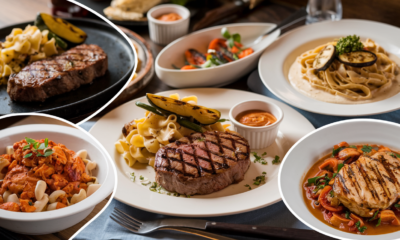
 Pasta Recipes10 months ago
Pasta Recipes10 months ago5 Delicious Steak and Pasta Recipes
-
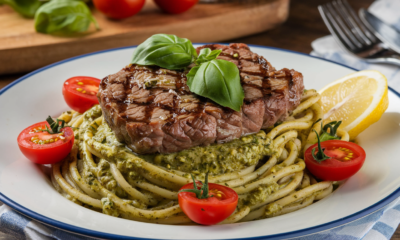
 Pasta Recipes10 months ago
Pasta Recipes10 months agoDelicious & Delightful Steak and Pesto Linguine Recipe
-
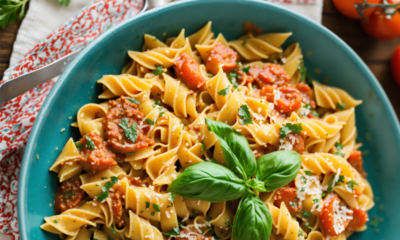
 Pasta Recipes9 months ago
Pasta Recipes9 months agoSwirly Pasta Recipe: Creative, Fun, and Delicious
-
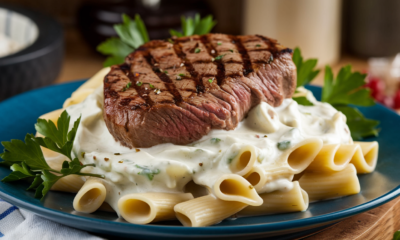
 Pasta Recipes10 months ago
Pasta Recipes10 months agoDelicious & Creamy Steak Alfredo Recipe
-

 Pasta Recipes9 months ago
Pasta Recipes9 months agoBrown Rice Pasta Recipe: A Healthy, Gluten-Free Alternative
-
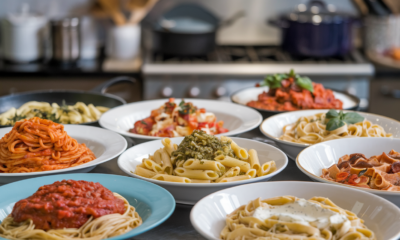
 Pasta Recipes10 months ago
Pasta Recipes10 months ago10 Easy Pasta Recipes for Busy Weeknights
-

 Pasta Recipes9 months ago
Pasta Recipes9 months agoSacchetti Pasta Recipe: Little Pouches of Flavor to Impress






